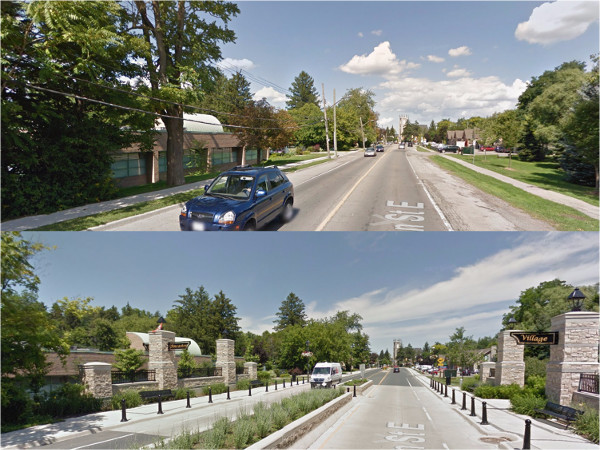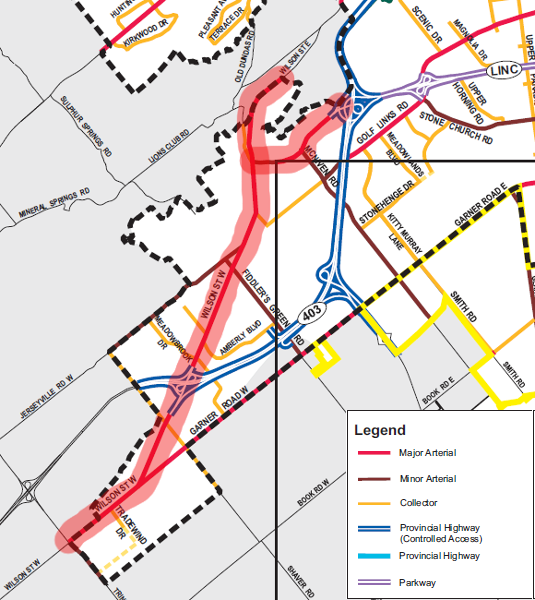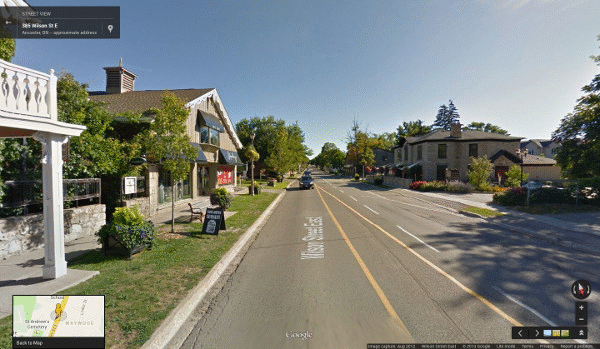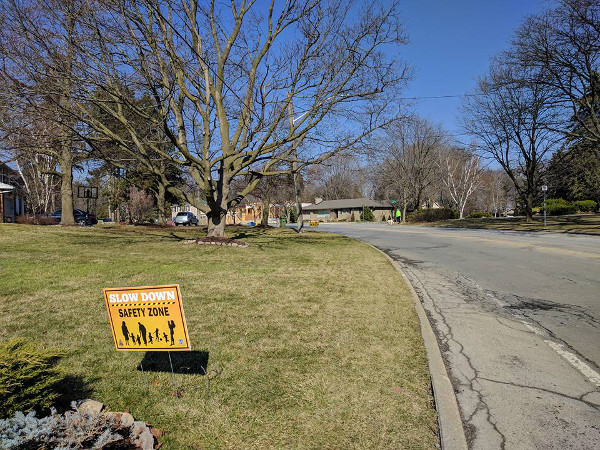It's great that Councillor Lloyd Ferguson recognizes the value of safe streets in Ancaster. He just needs to extend the same understanding to residents in the rest of the city.
By Ryan McGreal
Published June 06, 2017
A CBC Hamilton article on yesterday's Public Works Committee meeting drops with a sickening thud under the weight of a serious contender for the most tone-deaf councillor comment of the year:
A suburban councillor says "parochial" inner city councillors should stop trying to limit traffic on important city roads.
Ancaster's Lloyd Ferguson also had some pointed advice for people who live on busy streets.
"I am getting really tired of parochial lower city councillors wanting to turn our arterial roads into local streets," he said at a public works committee meeting Monday that was dominated by traffic issues.
His comments were made in the midst of a debate on a recurring topic at council in recent months: Do lower-city arterial roads belong to the whole city, or the neighbourhoods they run through?
"If you don't want to live on a busy street, then don't buy a house there," said Ferguson, saying he's tired of the debate.
"You don't expect the rest of the city to adjust the street to accommodate your personal needs when you made the decision to move there in the first place."
This is not the first time Councillor Ferguson has objected to efforts to make city streets safer and more inclusive for the people who actually live and work on and around them, but it comes right on the heels of a preventable tragedy last month when a cut-through driver struck and killed a ten-year-old girl in Waterdown who was trying to cross the street in front of her house.
The cruel irony here is that Ferguson clearly recognizes the value of traffic calming and pedestrian safety for his own constituents.

Before-and-after comparison of Wilson Street in Ancaster (Image Credit: Google Streetview)
Wilson Street and Mohawk Road in Ancaster are both classified [PDF] as Major Arterials under the Urban Hamilton Official Plan (and the short 400 m stretch of Rousseau just east of Wilson that turns into Mohawk is a designated Minor Arterial).
Yet both received extensive traffic calming measures, including bike lanes, medians, pedestrian crossings and lane narrowing in their recent reconstructions as part of the Ancaster Traffic Plan.

Wilson Street and Mohawk Road/Rousseau Street highlighted in the City's road classification map with superimposed map legend (Image Credit: Urban Hamilton Official Plan, Appendix 11)
These are not just minor side streets - they are major arterials in both formal designation and automobile traffic volume. Wilson Street carries 18,000 cars a day on just one lane in each direction. Mohawk Road between Wilson and Highway 403 carries an extraordinary 25,000 cars a day - also on just one lane in each direction!
Can you imagine the howls of outrage if there was a proposal to convert, say, Aberdeen Avenue, which carries a similar traffic volume, to a complete street with just one lane in each direction?
Just kidding! We don't have to imagine the reaction. Council pushed back aggressively and the motion to make Aberdeen safer was punted down the road. Even a "housekeeping motion" asking staff to look at interim measures turned into a fiasco.
Indeed, just a couple of months ago, Ferguson objected to a timid set of measures to test some minor traffic calming measures on Aberdeen:
Ancaster Coun. Lloyd Ferguson scolded "parochial" lower city councillors for trying to "choke up" roads used by all city residents, while Ward 3 Coun. Matthew Green said the city should always "give precedence to resident safety over resident convenience."
Meanwhile, a 2011 Ancaster News article about the planned traffic calming measures on Wilson Street is worth quoting at some length here:
"I can't turn my back on the staff who are trying to deliver on the safety issue, said Ferguson.
The centre left-turn lanes would also provide opportunities for pedestrians to cross Wilson Street without signalized crossings.
"It's not the best, but if somebody wants to cross in between controlled intersections, it gives pedestrians a little safe place, too. It's not great, but it's better than nothing." Ferguson said he agrees with those concerned by a lack of pedestrian crossings on Wilson Street. He is proposing the addition of two crosswalks.
"I think we should have two more pedestrians crossings," said Ferguson.
It's excellent that Ferguson advocated for meaningful pedestrian safety improvements on Wilson Street to ensure his constituents are better served by a safer, more inclusive street. Ferguson clearly understands that his constituents value safety - including safety for people on foot.
So it is even more unfortunate that Ferguson seems unwilling to extend that same understanding to people who live on streets in other wards that he regards as nothing more than thoroughfares to somewhere else.
A few years ago, McMaster transportation researcher Chris Higgins wrote a satirical article for RTH in which he postulated what Wilson Street in Ancaster would look like if the City applied the same transportation priorities there that it has applied on lower city streets.
It's not pretty:

Animated GIF: Wilson Street given the Main Street West treatment (Image Credit: Google Streetview)
Of course, Ferguson and his residents would never tolerate such an abusive, oppressive street design for their own community - and rightly so. But this is exactly what has been imposed on every major street across the lower city.
It is long past time to end the double standard of safety and dignity. Every single person in Hamilton deserves to live, work and travel on safe, inclusive streets. There is nothing more important than fundamental health and safety.
Streets that have been designed and built as complete streets are safer for everyone, including people on foot, people riding transit, people on bikes, and people in cars.
Enough of the classist, exclusionary idea that people who, ahem "made the decision" to drive through a neighbourhood deserve a higher priority than people who want to live and work in that neighbourhood without the daily risk of being maimed and killed by dangerous, high-speed automobile traffic.
By now you've probably noticed the "SLOW DOWN - SAFETY ZONE" signs that have proliferated on streets in every part of the city. If nothing else, these signs tell us that all Hamiltonians recognize and value traffic calming and safety on their own streets.
I don't think it's too much to ask people to make the logical and ethical leap from their own experience to an agreement that everyone else also deserves the same fundamental safety they want for themselves.

SLOW DOWN - SAFETY ZONE sign on Scenic Drive (RTH file photo)
By kevlahan (registered) | Posted June 06, 2017 at 08:42:30
Here is a comment about the difference between "busy" and "complete" (safe and convenient for all street users) I posted on another article regarding Councillor Ferguson's comments:
Unfortunately, Councillor Ferguson is confused about the difference between a "busy" street and a "safe" (or complete) street.
Maybe you shouldn't complain about busy traffic if you decide to live on an arterial street. But that doesn't mean the street can't be complete: i.e. safe and convenient for all street users. Indeed, Ancaster has a generalized 40 km/h speed limit, and introduced elements of complete streets on Wilson Street, which is arterial.
And you could equally claim that commuters shouldn't complain about congestion if they "choose" not to live within walking distance of their work. After all, if it is really always a simple matter of choice, everyone could choose to live close to their work (or find a job close to where they live). Obviously, it is not that simple and unless you want to ban residents from arterials streets it is unfair not to make these streets safe for residents, pedestrians, cyclists (and motorists). High traffic volume streets don't need to be dangerous!
I saw a whole whack of those "Slow Down - Safety Zone" signs in Waterdown last evening on Mill Street immediately north of Hwy. 5/Dundas St.
By Connie (registered) | Posted June 06, 2017 at 11:24:49
As a pedestrian/cyclist, I have become aware and very wary of the mentality of commuter and commercial traffic in the core. They are programmed for getting from A to B as fast as possible, and anyone who interferes with that is just an obstacle to be bullied and harassed out of the way. A delay of even 5 seconds or less is intolerable to them.
I agree that traffic calming measures are important. However, I think some driver education is in order too, reminders that pedestrians, cyclists, elders and children have as much need, and right, to use the streets as vehicles do. Drivers in Hamilton are much more aggressive than in gridlocked downtown Toronto, because they are accustomed to treating downtown arterial streets as high speed commuter roads instead of the residential/shopping areas they really are. Along with physical traffic calming, drivers, and some Councillors, need some direct education in the courtesies of commuting through our downtown neighbourhoods.
Comment edited by Connie on 2017-06-06 11:27:01
By RobF (registered) | Posted June 06, 2017 at 12:37:28
I find it bizarre that we still need to justify complete streets and traffic calming measures. When intensification is raised in Ancaster, such as a recent proposal for stacked townhouses on Wilson Street, what do nearby residents/homeowners say: what about the added noise and traffic?
But when residents of downtown neighbourhoods ask for traffic calming on thru streets in residential areas that's selfish. Really?
You must be logged in to comment.
There are no upcoming events right now.
Why not post one?